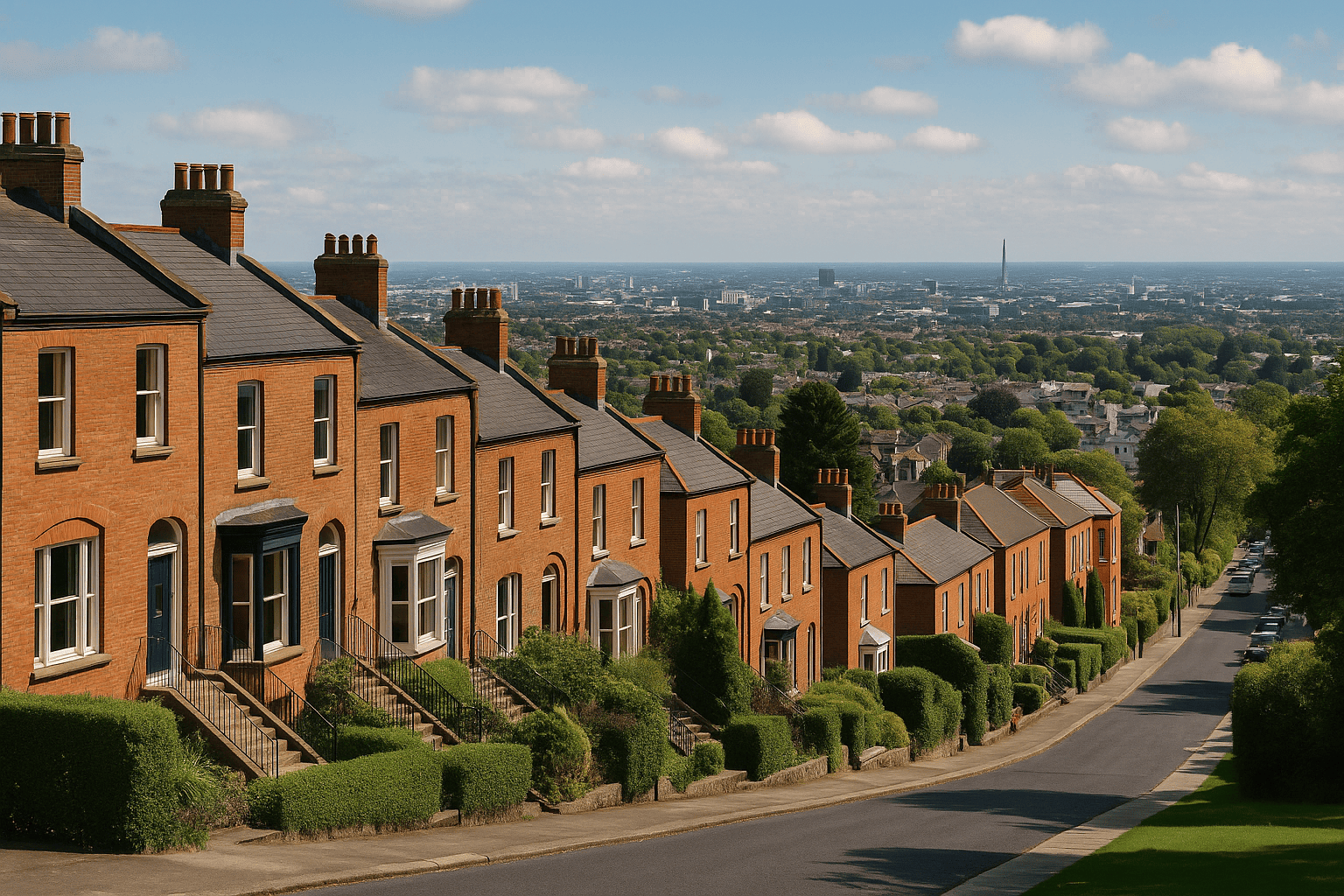
The Geography of Change
According to the Central Statistics Office (CSO), the average home price across Ireland reached €370,000 in mid-2025, up 7.9% year-on-year. Outside Dublin, growth was even stronger — almost 9% — while the capital saw a more modest 6% rise.
For years, Dublin defined Ireland’s housing narrative: tech hubs, international companies, and sky-high rents. But that gravitational pull is shifting outward. Families, migrants, and first-time buyers are heading toward Kildare, Meath, Dublin 5, and Dublin 13, trading proximity for space, and density for air.
“People are no longer buying for status,” says Owen Reilly, a Dublin-based real estate broker. “They’re buying for sanity. For a bit of garden, for schools they can walk to, for a life that feels human.”
Life Beyond the M50
Suburban Ireland has grown up.
Rail lines and motorways have stitched once-sleepy towns into the national fabric. You can now live in Drogheda or Maynooth and commute to the capital in under an hour. Cafés hum with remote workers. Primary schools fill faster than developers can build.
In Dún Laoghaire-Rathdown, median prices hover around €675,000, while twenty kilometers away in Kildare, a spacious family home costs nearly half that. Infrastructure, not distance, has become the new currency of value.
The same pattern plays out globally. In Bulgaria, for instance, property buyers have also drifted away from Sofia toward coastal or mountain regions. But while Bulgaria offers lower prices, Ireland offers stability — a transparent market, strong legal protection, and community life that functions rather than promises.
“People underestimate the emotional infrastructure of Ireland,” says Dr. Rónán Lyons, economist at Trinity College Dublin. “It’s not just transport and schools. It’s the feeling that the system, for all its flaws, still works.”
The Supply Squeeze
The shortage of homes is Ireland’s open secret.
In 2024, just over 30,000 new dwellings were completed — 6.7% fewer than the year before. Apartment completions fell by almost a quarter. Developers cite higher material and labor costs, along with planning delays that can stretch for years.
For ordinary people, those statistics translate into waiting lists, bidding wars, and compromises.
“We wanted four bedrooms and a garden,” says Elena, a Ukrainian nurse who settled in Meath. “After a year of searching, we bought three — but it’s warm, safe, and near the train. That’s what matters.”
The rental market offers little relief. Only around 2,000 properties were available nationwide in early 2024, the lowest figure in a decade. Average monthly rent: €1,680, rising to over €2,000 in Dublin. For young professionals and migrants, affordability is a moving target.
Government efforts, like the Cost Rental Scheme, have begun to help middle-income renters, but coverage remains limited. Demand still vastly outweighs supply.
And yet — Irish homes have soul. Even modest new builds carry a sense of craft: large windows, thick insulation, clean lines. The interiors are bright and warm, designed not to impress but to endure. In a country where rain is a season unto itself, warmth is architecture’s quiet form of love.
Migrants and Investors: Different Roads, Same Goal
For migrants, housing is the first real test of integration.
Ireland allows foreigners to buy property freely, but banks often require a higher deposit — typically 20-30% — and evidence of income earned within the state. That can slow first-time purchases but not deter them.
For newcomers, renting first is still the wisest path. Landlords tend to prefer tenants with stable contracts and local references, so preparation is key.
For investors, the numbers are persuasive. Rental yields average 5-7%, and demand shows no sign of slowing. Energy-efficient homes (rated A on the BER scale) are the market’s rising stars — compliant with EU sustainability targets and attractive to tenants conscious of utility costs.
Compared with markets like Bulgaria, Ireland’s entry prices are higher but its long-term fundamentals stronger: EU membership, steady GDP growth, and an English-speaking environment. Here, property is less speculation and more legacy.
A Market of Character, Not Just Numbers
Housing in Ireland is never just about square meters. It’s about weather, light, and texture. It’s about waking up to gulls on the coast, or watching the mist lift from the Wicklow hills. Even in suburban estates, there’s a quiet poetry to how people make homes their own — bright doors, climbing roses, the ritual of repainting before Christmas.
That emotional intelligence sets Ireland apart. Where many countries treat real estate as arithmetic, Ireland treats it as biography. Each house tells a story — of arrival, ambition, or continuity.
The Road Ahead
Analysts at CBRE forecast moderate price growth of around 4-6% through late 2025, supported by high employment and continued inward migration. Supply will remain tight, but infrastructure investments — particularly in regional transport — may gradually ease pressure on Dublin.
Ireland’s housing challenge is far from solved. But it is also far from hopeless.
This is a country still building, still believing, still adjusting. Its suburbs are not escape routes but destinations in themselves — greener, slower, and quietly prosperous.
Closing Thought
The Irish dream has evolved. It’s no longer about a semi-detached in Dublin with a view of the Liffey. It’s about a home that feels alive — where warmth is real, neighbors matter, and a mortgage, though heavy, still carries the weight of belonging.
For those arriving, investing, or simply staying, Ireland’s property market remains more than an economy. It’s a human story — told one warm lighted window at a time.
